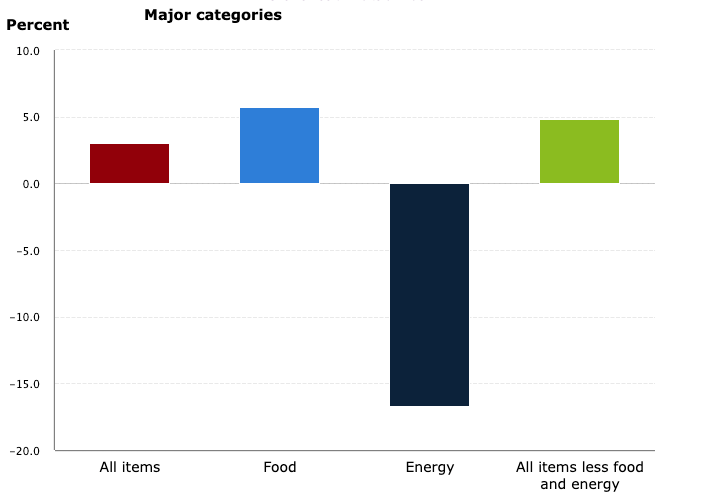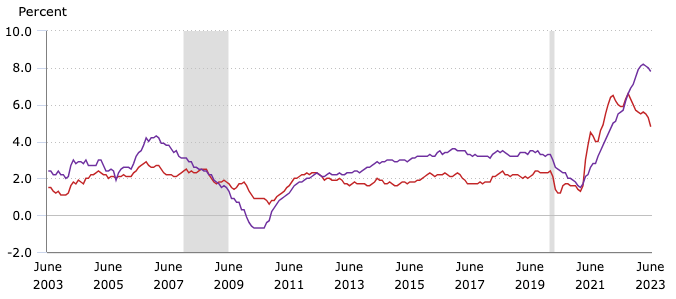Marcia G. from Tacoma, WA asks: Hi Mitch, I saw that the latest inflation numbers were a great improvement, and the stock market keeps going up. I’m writing to ask if you think this will continue. I know the market will go up and down over time, so my question is focused on inflation. Does it keep getting better from here? Thank you.
Mitch’s Response:
Thanks for writing – you’re right to point out improving inflation data. Year-over-year changes in the consumer price index peaked at 9.1% last June, falling to 4% in May and now 3% in June. That’s a solid downtrend, in my view, and I see a possibility that pressures could ease further in the second half of the year.1
But it may not happen immediately. One factor to consider is that June 2023’s inflation print is a year-over-year comparison to the inflation peak in June 2022, so the comparisons will become harder from here. I also think it’s important to focus on Core CPI, not the headline figure when wrapping your head around where the U.S. and the Fed are in the inflation battle.2
Looking to Protect Your Retirement from Inflation?
While inflation’s unpredictable nature can impose significant costs on the economy, what can investors, especially those nearing retirement, do to keep their investments afloat?
Instead of letting the pressures of inflation cause you to worry, I recommend that you take a look at steps that could help reduce the sting of it. To help, we’re offering our exclusive guide, 4 Ways to Protect Your Retirement from Rising Inflation3. You will get insight on:
- How to build or modify your asset allocation to outperform inflation
- The importance of analyzing your spending by category
- Strategies to maximize Social Security retirement benefits
- Plus, more practical ideas to fight back against inflation
If you have $500,000 or more to invest, get our free guide today! Download 4 Ways to Protect Your Retirement from Rising Inflation3.
Doing so paints a slightly less rosy picture. Core CPI, which strips out volatile food and energy categories, rose by 4.8% year-over-year in June, which also registered as a solid improvement from May’s 5.3% print but reveals a much greater distance to the Fed’s 2% target. Core CPI matters more to the Fed since they view food and energy contributions as highly volatile and also because they view the core measure as a better predictor of future inflation. As seen in the chart below, for instance, Energy was an outsized driver of the 3% headline figure, which could change considerably from month to month.

Source: U.S. Labor Department4
Because of the June 2022 to June 2023 comparison, I would not be surprised if the July inflation reading is slightly higher than June’s. I wouldn’t take that as a signal that inflation is back on the move. Underlying inflation pressures have been falling, and I think will continue to do so. If I had to cite three factors that will drive inflation lower in the coming months and quarters, I would look at producer prices, M2 and M4 money supply, and owner’s equivalent rents. All of these measures should contribute to further downward pressure from here.
Specifically, the ‘shelter component’ of CPI is about one-third of the index reading. One feature is a quirky component called owner’s equivalent rent (OER). This component is what homeowners would hypothetically pay to rent their own houses, and it continues to place upward pressure on the headline figure as seen in the chart below:
The Shelter Component of CPI (purple line) Lags the Headline CPI figure (red line)

Source: U.S. Labor Department5
Data on home prices and rents suggest this pressure is going to fade significantly in the coming months, which should only pull the Core figure even lower. As far as reaching the Fed’s 2% target, I’m not sure that’s in the cards for 2023. But I also do not think we need a recession to get there. I would argue that inflation can gradually scale lower with below-trend growth, which is what the U.S. economy has been producing in 2023. An economic “soft-landing” is looking increasingly likely.
In the meantime, I recommend taking steps to prevent inflation from affecting your long-term investments. To help you, I am offering our exclusive guide, 4 Ways to Protect Your Retirement from Rising Inflation6. You will get insight on:
- How to build or modify your asset allocation to outperform inflation
- The importance of analyzing your spending by category
- Strategies to maximize Social Security retirement benefits
- Plus, more practical ideas to fight back against inflation
If you have $500,000 or more to invest, get our free guide today!
Disclosure
2 Wall Street Journal. July 12, 2023. https://www.wsj.com/articles/consumer-price-index-report-june-inflation-ede7f4b1?mod=economy_lead_pos4
3 Zacks Investment Management reserves the right to amend the terms or rescind the free 4 Ways to Protect Your Retirement from Rising Inflation offer at any time and for any reason at its discretion.
4 U.S. Bureau of Labor Statistics. 2023. https://www.bls.gov/charts/consumer-price-index/consumer-price-index-by-category.htm
5 U.S. Bureau of Labor Statistics. 2023. https://www.bls.gov/charts/consumer-price-index/consumer-price-index-by-category.htm
6 Zacks Investment Management reserves the right to amend the terms or rescind the free 4 Ways to Protect Your Retirement from Rising Inflation offer at any time and for any reason at its discretion.
DISCLOSURE
Past performance is no guarantee of future results. Inherent in any investment is the potential for loss.
Zacks Investment Management, Inc. is a wholly-owned subsidiary of Zacks Investment Research. Zacks Investment Management is an independent Registered Investment Advisory firm and acts as an investment manager for individuals and institutions. Zacks Investment Research is a provider of earnings data and other financial data to institutions and to individuals.
This material is being provided for informational purposes only and nothing herein constitutes investment, legal, accounting or tax advice, or a recommendation to buy, sell or hold a security. Do not act or rely upon the information and advice given in this publication without seeking the services of competent and professional legal, tax, or accounting counsel. Publication and distribution of this article is not intended to create, and the information contained herein does not constitute, an attorney-client relationship. No recommendation or advice is being given as to whether any investment or strategy is suitable for a particular investor. It should not be assumed that any investments in securities, companies, sectors or markets identified and described were or will be profitable. All information is current as of the date of herein and is subject to change without notice. Any views or opinions expressed may not reflect those of the firm as a whole.
Any projections, targets, or estimates in this report are forward looking statements and are based on the firm’s research, analysis, and assumptions. Due to rapidly changing market conditions and the complexity of investment decisions, supplemental information and other sources may be required to make informed investment decisions based on your individual investment objectives and suitability specifications. All expressions of opinions are subject to change without notice. Clients should seek financial advice regarding the appropriateness of investing in any security or investment strategy discussed in this presentation.
Certain economic and market information contained herein has been obtained from published sources prepared by other parties. Zacks Investment Management does not assume any responsibility for the accuracy or completeness of such information. Further, no third party has assumed responsibility for independently verifying the information contained herein and accordingly no such persons make any representations with respect to the accuracy, completeness or reasonableness of the information provided herein. Unless otherwise indicated, market analysis and conclusions are based upon opinions or assumptions that Zacks Investment Management considers to be reasonable. Any investment inherently involves a high degree of risk, beyond any specific risks discussed herein.
The S&P 500 Index is a well-known, unmanaged index of the prices of 500 large-company common stocks, mainly blue-chip stocks, selected by Standard & Poor’s. The S&P 500 Index assumes reinvestment of dividends but does not reflect advisory fees. The volatility of the benchmark may be materially different from the individual performance obtained by a specific investor. An investor cannot invest directly in an index.